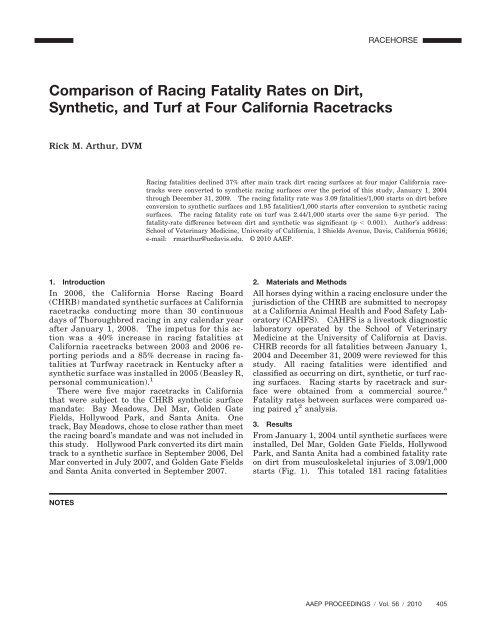Retired Racehorses
tfrr_reportandappendicesfinal
tfrr_reportandappendicesfinal
- No tags were found...
Create successful ePaper yourself
Turn your PDF publications into a flip-book with our unique Google optimized e-Paper software.
RACEHORSE<br />
Comparison of Racing Fatality Rates on Dirt,<br />
Synthetic, and Turf at Four California Racetracks<br />
Rick M. Arthur, DVM<br />
Racing fatalities declined 37% after main track dirt racing surfaces at four major California racetracks<br />
were converted to synthetic racing surfaces over the period of this study, January 1, 2004<br />
through December 31, 2009. The racing fatality rate was 3.09 fatalities/1,000 starts on dirt before<br />
conversion to synthetic surfaces and 1.95 fatalities/1,000 starts after conversion to synthetic racing<br />
surfaces. The racing fatality rate on turf was 2.44/1,000 starts over the same 6-yr period. The<br />
fatality-rate difference between dirt and synthetic was significant (p 0.001). Author’s address:<br />
School of Veterinary Medicine, University of California, 1 Shields Avenue, Davis, California 95616;<br />
e-mail: rmarthur@ucdavis.edu. © 2010 AAEP.<br />
1. Introduction<br />
In 2006, the California Horse Racing Board<br />
(CHRB) mandated synthetic surfaces at California<br />
racetracks conducting more than 30 continuous<br />
days of Thoroughbred racing in any calendar year<br />
after January 1, 2008. The impetus for this action<br />
was a 40% increase in racing fatalities at<br />
California racetracks between 2003 and 2006 reporting<br />
periods and a 85% decrease in racing fatalities<br />
at Turfway racetrack in Kentucky after a<br />
synthetic surface was installed in 2005 (Beasley R,<br />
personal communication). 1<br />
There were five major racetracks in California<br />
that were subject to the CHRB synthetic surface<br />
mandate: Bay Meadows, Del Mar, Golden Gate<br />
Fields, Hollywood Park, and Santa Anita. One<br />
track, Bay Meadows, chose to close rather than meet<br />
the racing board’s mandate and was not included in<br />
this study. Hollywood Park converted its dirt main<br />
track to a synthetic surface in September 2006, Del<br />
Mar converted in July 2007, and Golden Gate Fields<br />
and Santa Anita converted in September 2007.<br />
2. Materials and Methods<br />
All horses dying within a racing enclosure under the<br />
jurisdiction of the CHRB are submitted to necropsy<br />
at a California Animal Health and Food Safety Laboratory<br />
(CAHFS). CAHFS is a livestock diagnostic<br />
laboratory operated by the School of Veterinary<br />
Medicine at the University of California at Davis.<br />
CHRB records for all fatalities between January 1,<br />
2004 and December 31, 2009 were reviewed for this<br />
study. All racing fatalities were identified and<br />
classified as occurring on dirt, synthetic, or turf racing<br />
surfaces. Racing starts by racetrack and surface<br />
were obtained from a commercial source. a<br />
Fatality rates between surfaces were compared using<br />
paired 2 analysis.<br />
3. Results<br />
From January 1, 2004 until synthetic surfaces were<br />
installed, Del Mar, Golden Gate Fields, Hollywood<br />
Park, and Santa Anita had a combined fatality rate<br />
on dirt from musculoskeletal injuries of 3.09/1,000<br />
starts (Fig. 1). This totaled 181 racing fatalities<br />
NOTES<br />
AAEP PROCEEDINGS Vol. 56 2010 405


